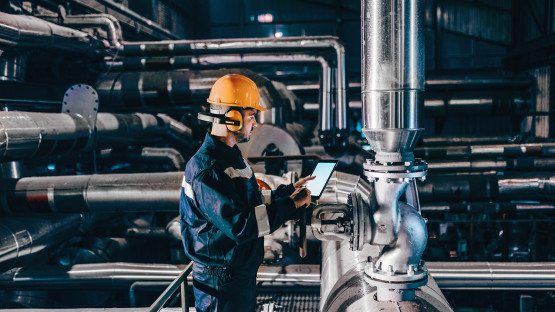
If you would like to learn more about the IAEA’s work, sign up for our weekly updates containing our most important news, multimedia and more.
Industry engagement
Safeguarding a changing nuclear landscape
Wolfgang Picot

The emergence of new reactor designs requires changes in the nuclear industry’s approach to safeguards, industry experts say.
Photo: (D. Calma/IAEA)
As global demand for nuclear power continues to increase, engagement between the nuclear industry and the IAEA is becoming more important. Facility designs are significantly changing, with the introduction of new reactor types such as liquid-fuelled advanced reactors or transportable microreactors. The emergence of these new reactor designs, along with the increased interest shown by more countries in nuclear power, requires changes in the industry’s approach to safeguards, industry experts say.
“Industry supports safeguards; it knows safeguards are important. Companies take responsibility for nuclear material in their facilities,” said Sama Bilbao y León, Director General of World Nuclear Association. “However, beyond those who deal with them directly, safeguards are not very well known to the average nuclear industry employee. In contrast to safety, not everyone has safeguards on the top of their minds.”
While safeguards may not be at the forefront for some, international affairs are placing the role of the IAEA and safeguards into the spotlight. Staff across the nuclear industry are becoming more aware of international nuclear safeguards, said Jo Anna Bredenkamp, Director of Global Nuclear Safeguards and Strategic Export Programs at Westinghouse Electric Company. “News in the field of non-proliferation makes people more aware,” she added.
The growing interest in nuclear energy in many parts of the world is also contributing to the increased awareness of safeguards. “This is a very timely discussion,” Bredenkamp said. “More States have become interested in nuclear power. As we look at export opportunities to these countries, we see that we have to address potential customers’ concerns about safeguards from the start of the bidding process.”
Economics and the ‘bottom line’ are a primary concern for corporations when it comes to new reactor designs. Vendors are integrating safeguards early in the design process for novel reactor types in order to avoid costly adjustments later — something commonly referred to as ‘safeguards by design’.
“As a company, we have to look at the most economic view for designing a power plant based on a novel concept,” Bredenkamp explained. “If you build a demonstration plant and have not thought about safeguards from the start, retrofitting it gets costly. Microreactors, for example, are so small that there is not much space for additional wiring or sensors after a unit has been built. As a company, we need to have a role in safeguards because the new business models do not fit the previous regime of ‘retrofitting’ safeguards in existing facilities.”
Nuclear waste repositories are another area where industry should consider integrating safeguards by design, Bilbao y León said. “We are not only now starting to consider safeguarding nuclear waste in the implementation of deep geological repositories. Any such project has included safeguards from the start. We have thought about this for a long time.”
As the industry proactively considers safeguards, the IAEA plays an essential role in helping implement safeguards by design. The IAEA regularly hosts ‘safeguards by design’ workshops with representatives from regulatory entities, industry and IAEA staff, focusing on themes such as decommissioning, waste, spent fuel and small modular reactors.


